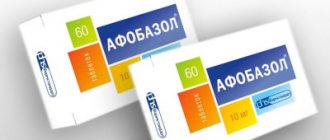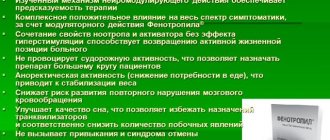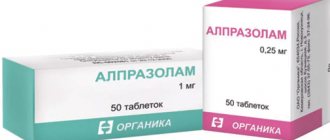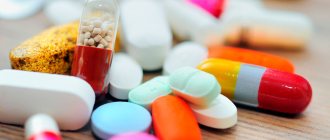09/15/2021 Non-steroidal anti-inflammatory drugs (NSAIDs or NSAIDs) are widely used against inflammatory processes in the body. Medicines are sold in tablet form, capsules, and dosage forms for external use. They not only have an anti-inflammatory effect, but also reduce temperature and also relieve pain.
The drugs have contraindications and side effects, so the doctor must select them, taking into account the individual characteristics and condition of the patient.
Sulbutiamine
Sulbutiamine is a “doubled” molecule of vitamin B1 or thiamine. It has an increased ability to dissolve in lipids, which contributes to improved penetration of this compound through the blood-brain barrier into the brain.
Sulbutiamine
999 rub.
Sulbutiamine breaks down into thiamine and improves trophic processes in nervous tissue, leading to an increase in cholinergic conductivity, which normalizes and stabilizes the integrative activity of the brain. Sulbutiamine also accumulates in the cells of the reticular formation, enhancing their activity in activating the cerebral cortex. This leads to a reduction in asthenic symptoms, increased motivation, improved cognitive activity and restoration of a person’s “aliveness”.
Popular anti-inflammatory drugs
Ibuprofen
The drug fights all types of pain, including inflammation of the joints, and relieves fever. Often used for pain due to cramps that occur during menstruation.
Available in tablet form.
| Ibuprofen Welfarm tab 0.4 x 30 |
| Ibuprofen tab 0.2 x 50 |
| Ibuprofen tablet p/p 400 mg x 10 |
| Ibuprofen tab 0.2 x 20 |
Diclofenac
Prescribed for the treatment of rheumatic diseases. Reduces swelling and stiffness of joints in the morning. Increases motor range in case of joint diseases. A stable effect is achieved after 1-2 weeks of treatment.
| Diclofenac amp 25mg/3ml x 5 (Grotex) |
| Diclofenac amp 25mg/3ml x 10 |
| Diclofenac amp 25mg/3ml x 5 |
Dolgit
Product for external use. Thanks to the phenylpropionic acid derivative in its composition, it relieves pain and inflammation. Effectively combats joint stiffness in the morning and provides increased mobility in the joints.
The dosage form is cream in tubes.
| Dolgit gel 5% 100 mg |
Voltaren Emulgel
Topical preparation. Intended for adults and children over fourteen years of age.
Diclofenac in the composition helps relieve discomfort and relieves inflammation. The gel-like emulsion is quickly absorbed into the skin, which provides almost instantaneous action.
Relieves swelling of injured joints, muscles, tendons, soft tissues. Relieves pain from tendinitis, bursitis and rheumatism.
Available in gel form in tubes.
| Voltaren Emulgel 1% 100 mg |
Nurofen Express Forte
The drug is in capsule form. Designed to relieve pain of various origins. A popular remedy for menstrual and neuralgic pain. For colds and flu, it relieves discomfort in muscles and joints. The medicine can be taken by adults and children from the age of twelve. It is not allowed to take more than three tablets per day.
| Nurofen Express Forte 400 mg No. 20 |
Meloxicam
The medicine blocks the body's production of substances that cause inflammation and pain. Has antipyretic properties. Reduces sensitivity, relieves discomfort, stiffness and inflammation in osteoarthritis and rheumatoid arthritis. Normalizes the condition of juvenile rheumatoid arthritis that occurs in childhood.
| Meloxicam tab 7.5 mg x 20 |
| Meloxicam-Prana tab 15mg No. 20 |
| Meloxicam-Prana tab 7.5 mg No. 20 |
Amelotex
The drug is based on Meloxicam. Increases the motor volume of joints. In a short time it fights inflammation and discomfort thanks to its chondroprotective properties.
The course of treatment is three to four weeks. Amelotex should be applied twice a day.
The dosage form is gel.
| Amelotex gel 1% 30g |
Nise
Product based on Nimesulide. The active substance, in addition to relieving pain, removes swelling. Has antioxidant properties.
The drug relieves symptoms of osteoarthritis, rheumatism, neuralgia, fever, bursitis, tendonitis, ankylosing spondylitis.
| Nise gel 1% 100g |
Dolobene gel
The active ingredient is ibuprofen, a component that relieves inflammation and pain. The duration of treatment is determined by the doctor. Usually for injuries, including sports, it is two weeks, for rheumatic diseases - three weeks.
It is used to relieve inflammation and swelling of soft tissues, treat bruises, deformations, and sprains.
Release form: gel in tubes.
| Dolobene gel 90g |
Nimesil
Often used after surgery. Effective for diseases of the musculoskeletal system (arthritis, arthrosis, etc.) during periods of deterioration of health. Fights fever caused by infectious diseases or other reasons. The drug is good for improving the condition of soft tissues and joints. It is used for therapy in urology, gynecology, disorders of the vascular system, and degenerative changes in the body.
Available in the form of granules for preparing a suspension.
| Nimesil granules for suspensions 100 mg No. 30 |
Nimesulide
Clinical studies have shown that Nimesulide is able to relieve pain in a relatively short time - about twenty minutes. This allows the drug to be used to combat acute conditions.
Indications for use are arthritis, tendinitis, pathologies in the field of gynecology, infectious diseases, inflammatory processes after surgery.
| Nimesulide Welfarm tab 100 mg x 20 |
| Nimesulide-lect tab 100mg No. 40 |
| Nimesulide gran d/susp pack 100 mg x 30 |
Ketonal Duo
Relieves pain, inflammation, fever. Thanks to the prolonged action, relief is felt longer.
After consumption, the drug is absorbed directly from the gastrointestinal tract into the blood, where it is maximally concentrated after about a couple of hours.
Release form: capsules with gradual release of the active substance.
| Ketonal Duo capsules 150g No. 30 |
Ketoprofen
Topical application in gel form.
It is used in the presence of morning stiffness of the joints, weakens the course of arthralgia. Effectively helps relieve muscle pain and combat post-traumatic lesions. Before using the drug, it is worth considering other treatment methods. If treatment with Keptrofen is necessary, it is recommended to use the smallest dosage and the shortest time of use, based on the expected results of therapy.
| Ketoprofen gel 2.5% 40g |
Movalis
Contains meloxicam, a derivative of enolic acid. Intended for the initial stage of therapy and short-term symptomatic treatment. It is not combined with other drugs from the list of non-steroidal anti-inflammatory drugs and cannot be used together with them.
Available in the form of a solution for intramuscular injection.
| Movalis solution 15 mg No. 3 |
Revmart
Indications for use are inflammation of the joints and their degenerative changes, which are accompanied by pain: acute osteoarthritis, ankylosing spondylitis, chronic polyarthritis, rheumatoid arthritis, radiculitis and osteoarthritis.
The release form of the medicine is tablets.
| Revmart tab 15mg x 10 |
| Revmart tab 15mg x 20 |
| Revmart tab 7.5 mg x 20 |
Paracetamol
Analgesic non-narcotic drug used for mild or moderate pain: headache (including migraine), dental. Also used for sore throat, myalgia and neuralgia.
The drug reduces temperature for colds and various infectious diseases.
The drug relieves symptoms for the duration of its action, but does not affect the development of the disease.
| Paracetamol tab 0.5 x 20 |
Weldexal
Tablets and solutions are prescribed for acute and chronic forms of inflammatory diseases, metabolic and inflammatory-degenerative pathologies of the musculoskeletal system. Relieves pain of various origins: after surgery, dental pain, with metastases in bone tissue, during menstruation, radiculitis, renal colic, sciatica, neuralgia.
This is a symptomatic remedy that does not affect the progression of the disease.
| Weldexal tablet. p/p/o 25 mg No. 10 |
| Veldexal solution for IV and IM 25 mg/ml 2 ml x 5 |
Ketoprovel
Symptomatic medicine in tablet form. Relieves inflammation and pain in radiculitis, rheumatoid and seronegative arthritis, osteoarthritis, bursitis, cancer, neuralgia, tendonitis, algodismenorrhea, myalgia. Helps with toothache and headaches, as well as pain symptoms after injuries and operations.
| Ketoprovel tab 100 mg x 20 |
Ketorolac
Anti-inflammatory, analgesic drug with antipyretic effect.
Used for severe or moderate pain after injuries, operations, oncology, arthralgia, radiculitis, dental diseases, neuralgia.
Prescribed for symptomatic therapy.
| Ketorolac tab 10 mg x 20 |
| Ketorolac amp 30mg 1ml No. 10 |
Aponil
Used against inflammation, pain, elevated body temperature. Selectively inhibits COX-2, acting directly on the site of inflammation. Fights pain, fever and inflammation of the musculoskeletal system.
| Aponil tab 100 mg x 20 |
Aceclofenac
The symptomatic drug is used as part of complex therapy for inflammatory diseases of the musculoskeletal system, to relieve pain in glenohumeral periarthritis, rheumatism, and dental diseases. The product reduces joint swelling and eliminates morning stiffness.
| Aceclofenac Welfarm tab p/p/o 100 mg x 20 |
Acetylsalicylic acid
The product fights pain, fever, inflammation. Blocks the production of thromboxane A2, inhibiting platelet aggregation. Helps with mild to moderate pain.
Prescribed for adults and children over 15 years of age.
| Acetylsalicylic acid 500 mg x 20 |
| Acetylsalicylic acid 500 mg x 20 R |
Diclogen
The drug is used for short-term treatment of moderate pain in diseases of the musculoskeletal system, after operations and injuries, in diseases of the pelvic organs, as well as neuralgia and algodismenorrhea.
| Diclogen amp 25mg/3ml x 5 |
B vitamins and magnesium
The best anti-asthenic B vitamins are B3 and B6 vitamins (nicotinic acid and pyridoxine). We do not take thiamine into account due to the fact that sulbutiamine is a much more pronounced anti-asthenic drug, which we discussed in the previous paragraph. Pyridoxine is involved in the synthesis of GABA, and also increases the trophism of neurons, protects proteins from glycation by glucose and has a membrane-stabilizing effect.
B vitamins
329 rub.
Nicotinic acid is involved in the synthesis of nicotinamide dinucleotide, which is responsible for oxidative phosphorylation reactions in mitochondria and the production of ATP, the main energy currency of cells.
Magnesium prevents excessive excitation of neurons, has a calming and mood-stabilizing effect, and also relieves anxiety. The best effect is achieved by magnesium in combination with vitamin B6.
Cramps are involuntary muscle contractions that vary significantly in duration, intensity and location, etiology and pathogenesis. Depending on the mechanism of development, epileptic and non-epileptic seizures are distinguished. The latter may be associated with pathology of the central and peripheral nervous system. It is well known that the development of seizures is facilitated by disturbances in the mineral balance: in particular, hypomagnesemia [1–11]. Magnesium deficiency is often not taken into account when analyzing the pathophysiology of seizures of various etiologies. Meanwhile, the participation of magnesium in neuromuscular function has been convincingly proven using evidence-based medicine methods and the results of epidemiological studies [6, 13–15].
In studies by Wijst et al. (2009) found that one of the main regulators of seizures, dependent on the level of magnesium in the blood, is the magnesium channel TRPM6. The expression of this gene is influenced by certain hormones (for example, estrogens) and certain drugs (for example, cyclosporine), which change the acid-base balance and can increase convulsive readiness and even provoke it (cyclosporine A). Long-term use of drugs containing estrogen (replacement therapy and oral contraceptives) also provokes channel activity and increases magnesium loss, leading to magnesium-deficiency seizures (Fig. 1). TRPM6 channel activity depends on intracellular magnesium levels, pH, and ATP. Epidermal growth factor and estrogen receptors can also directly stimulate the activity of the TRPM channel, which regulates the absorption of magnesium in the distal tubules of the kidneys. The channel activity is also modeled by a number of proteins (RACK1, REA, RAC1) [14].
With age, the likelihood of calf muscle cramps, twitching of individual back muscles, etc. increases by 2–3 times, and magnesium levels decrease (Fig. 2). The main mechanisms of decline in magnesium levels with age include inadequate magnesium intake, decreased absorption, possibly due to decreased vitamin D intake, increased urinary losses due to diuretics and due to the above diseases of old age. Therefore, maintaining optimal magnesium levels in the elderly is a good working topic to study in large-scale clinical quality of life studies [16].
One of the first intravenous administrations of magnesium was made by the French obstetrician M. Bertrand in 1906 to relieve convulsions during eclampsia. Preeclampsia occurs in 5–50% of women and leads to the most severe complication of pregnancy – eclampsia. The generally accepted therapy is intravenous magnesium sulfate. A comparative study of gene expression was carried out in 10 placentas obtained after physiological labor, 10 from patients who had preeclampsia, and 8 placentas from patients with preeclampsia who received magnesium sulfate, which showed that in women with preeclampsia the expression levels of receptor genes are increased (p < 0.001). , similar to the calcitonin receptor (CRLR - calcitonine receptor-like receptor); receptor activity-modifying protein (RAMP-1) and inducible nitric oxide synthetase (iNOS). The use of magnesium sulfate leads to a statistically more significant (p < 0.05), higher expression of the calcitonin-related peptide (CGRP), CRLR gene and endothelial synthetase (eNOS) genes. These changes correspond to relaxation of the vascular endothelium, weakening of spasm and convulsive readiness. Calcitonin-related peptide, encoded by the CGRP gene, stimulates vasodilation through activation of CRLR with the participation of the RAMP-1 protein [15].
In medical practice, painful cramps of individual muscles are most known. They are associated with the appearance in the muscles (often after overload) of areas of local spasm: writer's cramp, night cramps of the calf muscles, spasm of the external pterygoid muscle when opening the mouth, cramps of various muscle groups in athletes. Areas of local muscle spasm are felt in the form of compactions, pressure on which is painful. Muscle overload is not the only cause of cramps. Toxic seizures are known; convulsions due to pyridoxine deficiency; with hypoglycemia; arising under the influence of psychogenic factors, with excessive physical exertion and muscle strain, tetanus, metabolic disorders, etc. Seizures occur especially easily in children, which is due to timely incomplete structural and functional maturation of the brain, intrauterine lesions of the central nervous system and developmental defects.
Regularly recurring convulsions indicate the primacy of magnesium deficiency and are described as “spasmophilia”, “constitutional tetany”, “normocalcium tetany”. Calcium therapy for patients in this group can further enhance the clinical manifestations of spasmophilia and seizures, while the pathophysiological treatment is the use of magnesium preparations [3].
Below we will consider the biochemistry of muscle contraction, the physiological role of magnesium, the relationship between magnesium deficiency and seizures, features of magnesium therapy, the synergistic effect of magnesium and one of its pharmacological carriers, orotic acid [4].
Biochemistry of muscle contraction
Skeletal muscle consists of millions of muscle fibers interconnected by connective tissue fibers. Muscle contraction is the shortening or change in tension of the muscle fibers that make up the muscle. The following types of contractions are distinguished: isometric, in which the length of the muscle fibers remains unchanged, but their tension increases, and isotonic - with shortening and thickening of the muscle, but without a significant change in its tension. Isometric and isotonic muscle contractions represent regular contraction-relaxation cycles, and cramps occur when the cyclicity of this process is disrupted.
The structural unit of muscle fiber is myofibrils - bundles of proteins organized in a special way, located along the cell. Two proteins are involved in contraction: myosin and actin, which are localized in the side chain of the muscle fiber.
Muscle contraction causes a nerve impulse, which through the neuromuscular synapse through the mediator is transformed into a mechanical effect. A nerve impulse in the action potential phase causes the release of Ca2+ ions, which interact with the proteins of muscle cells and cause contraction of myofibrils. Magnesium ions, on the contrary, are a physiological antagonist of calcium and mediate the relaxation of myofibrils.
In addition to participating in the functioning of myofibrils, magnesium plays an integral role in the transmission of nerve impulses. Magnesium is a physiological regulator of cell excitability, necessary for depolarization of the cell membrane of nerve and muscle cells. With a lack of magnesium, the cell becomes overexcitable. The most obvious molecular mechanism for the effect of magnesium on neuronal excitability is inhibition of the activity of NMDA receptors (glutamate receptors). Activation of NMDA receptors is necessary for rapid synaptic signal transmission in the brain, which occurs as a result of changes in the flow of sodium (potassium) across the membrane. Overstimulation of NMDA receptors can lead to epileptic-type seizures, while blocking them with magnesium reduces the excitability of neural pathways.
Because magnesium plays a fundamental role in the physiology of nerve impulse transmission and myofibril contraction, a decrease in its levels leads to increased neuromuscular excitability and causes tetany.
The following symptoms of magnesium deficiency in the body are known [13]:
- trembling (tremor) – a type of hyperkinesis, the appearance of automatic violent excessive movements that interfere with the performance of voluntary motor acts;
- tic - rapid involuntary muscle contractions, usually a circular spasm of the eye or facial muscles, which causes twitching of the corners of the mouth;
- knee reflex - extension of the lower limb in the knee joint when the tendon of the quadriceps femoris muscle is struck below the kneecap; evaluate its increase (revival), decrease, loss (if the reflex arc is damaged);
- Chvostek's symptom - caused by lightly tapping the trunk of the facial nerve with a finger or a hammer, most often in the area of the bifurcation of the facial nerve; Chvostek's symptom is an indirect sign of magnesium deficiency; it occurs in 4 out of 5 examined patients with magnesium deficiency;
- a symptom determined in a test with a tourniquet: when the shoulder is compressed with a tourniquet or cuff for 2-3 minutes after the disappearance of the pulse, tetanic convulsive contracture of the hand develops.
Clinically, with latent magnesium deficiency, the following specific neuromuscular signs associated with increased convulsive readiness can be identified:
- tingling in the area of the feet and palms (paresthesia) associated with overexcitation of sensory endings;
- hyperactivity: a person cannot stay in one place for a long time, constantly moves - even in sleep (restless legs syndrome, associated with increased excitability of skeletal muscles);
- muscle contractures, cramps (difficulty in cell repolarization);
- a feeling of “interruptions” in the work of the heart, extrasystole;
- digestive disorders: diarrhea, sometimes constipation, abdominal pain, sensation of a “lump” in the throat (spasm in the pharynx);
- urinary disorders: frequent urge, pain in the bladder area [6, 7, 13].
Magnesium therapy, its features
Magnesium requirements have been assessed in various epidemiological studies. It is interesting to analyze the latest large study assessing magnesium intake, conducted in China (2009) [15]. When assessing the diet of 324 people (55–70 years old), it was shown that the average magnesium content in erythrocytes was significantly lower (2.0 mmol/l) in patients with high blood pressure and a verified diagnosis of arterial hypertension (AH) compared to normotensive patients ( 2.2 mmol/l; p < 0.005). Dietary intake of magnesium was significantly lower in groups of patients diagnosed with hypertension (316 mg/day), diabetes mellitus (323 mg/day) compared with individuals with normal blood sugar and blood pressure (374 mg/day; p < 0. 05). When magnesium intake is below normal, muscle cramps develop within 1 to 6 weeks. In Russia, the current physiological daily requirement for magnesium in adults is about 400 mg/day (maximum – up to 800 mg/day). A balanced diet should contain magnesium in an amount of ≈ 400 mg/day, of which about 200 mg is adsorbed in a healthy person.
A decrease in the amount of magnesium taken daily can be compensated by an increasing adsorption of magnesium in the intestines and a decrease in its excretion through the kidneys. This can be promoted by eating certain foods. Thus, fresh vegetables and fruits contain relatively more actively absorbed magnesium than other foods. The required amount of magnesium is determined at the rate of 5 mg/kg/day. Some people need more magnesium due to significant magnesium losses. Children require 5 to 10 mg/kg/day, pregnant women (or nursing mothers) – 10–15 mg/kg/day, athletes or people engaged in heavy physical labor (depending on the load) – 10 to 15 mg /kg/day
There are primary and secondary magnesium deficiency. Primary magnesium deficiency is caused by congenital disorders of mineral metabolism: renal tubulopathy, decreased absorption of magnesium in the intestine, etc. Secondary magnesium deficiency occurs when there is insufficient replenishment of its losses (with food, drink). The mechanism of this condition lies not only in insufficient intake of magnesium, but also in increased losses in the urine. Secondary magnesium deficiency can also occur due to dysregulation of ion metabolism, gluten enteropathy, shortening of the intestine after resection, etc. If the cause of secondary magnesium deficiency is known, the situation can be normalized by acting on the root cause of the deficiency.
In case of magnesium deficiency of any etiology, correction of its content in the body is indicated. In a healthy person, the concentration of magnesium in the blood serum is maintained in a fairly narrow range (the norm is 0.75–1.26 mmol/l; in pregnant women, the lower limit is > 0.81 mmol/l). This extracellular magnesium is in continuous exchange with magnesium stores in bone and muscle tissue. In many cases, it is not possible to compensate for the lack of magnesium with dietary measures alone, and then there is a need to use pharmacological drugs containing magnesium. The disadvantages of magnesium preparations of the first generation include not only relatively low absorption and digestibility, but also its slow inclusion in metabolism. In the last 20 years, there has been a fairly strong tendency towards the transition to the use of II and subsequent generations of magnesium-containing preparations, in which the mineral is contained in the form of an organic salt or a complex with amino acids (for example, magnesium orotate).
Organic magnesium salts are not only much better absorbed by the body, but also have less side effects. Currently, magnesium preparations based on numerous organic salts continue to be used: orotate, asparaginate, lactate, magnesium citrate, etc. Therapy with magnesium preparations is more effective if administered simultaneously with the so-called. magnesium protectors – compounds that enhance the absorption of magnesium and its transport into the cell. Magnesium protectors include orotic acid, vitamins B6, D, B1, A, C and E, riboxin, carnitine, taurine and calcium preparations, since all these substances increase the magnesium content in the cell.
For seizures caused by hypocalcemia, hypomagnesemia, alkalosis, intravenous administration of calcium and/or magnesium is required, followed by their use [8]. In patients with epilepsy, complex therapy is supplemented with magnesium preparations [12].
Orotic acid preparations (orotate) are used for disorders of protein metabolism (in the post-infarction period, during fasting, liver diseases, in sports medicine, etc.). Orotic acid is a derivative of the pyrimidine base uracil and is involved in the biosynthesis of pyrimidine nucleotides, uridine monophosphate (UMP) and cytidine monophosphate. Increasing the concentration of orotate as a result of taking orotic acid salts significantly increases the concentration of UMP, uridine diphosphate (UDP) and uridine triphosphate (UTP) [5].
The mechanism of action of orotic acid is to increase the synthesis of UMP and other uridine phosphates, which are signaling molecules that interact with purinergic receptors and promote relaxation of smooth muscle and striated muscles. Orotic acid, like thiamine and pyridoxine, promotes the movement of magnesium into the cell. Therefore, the combination of magnesium with orotic acid enhances the effect of eliminating seizures.
When considering the treatment of magnesium deficiency seizures, you should pay attention to the drug MagnerotR (magnesium orotate; Worwag Pharma GmbH & Co., Germany). 1 tablet of the drug contains 500 mg of magnesium orotate, or 32.8 mg of pure magnesium. This salt is slightly soluble in water, does not bind hydrochloric acid of gastric juice, and does not have a laxative effect, unlike some other magnesium salts. Magnesium orotate is a good source of elemental magnesium, which is important for extracellular magnesium deficiency in the body [3].
Orotic acid salts are used as mineral carriers because orotic acid increases the cellular bioavailability of cations. In this case, orotic acid is a kind of transporter of magnesium ion into the cell. Thus, providing high bioavailability of magnesium, Magnerot® has a number of additional synergistic properties associated with the biological role of the orotic acid anion. This magnesium preparation has anabolic, hepatoprotective, uricosuric properties and can be used in long courses.
In patients after heart surgery, the recovery period is less likely to be complicated by heart failure and arrhythmia, and proceeds more favorably with metabolic therapy, including magnesium orotate [10]. Magnesium orotate can be used as an adjuvant therapy in people with severe heart failure, tachyarrhythmia and extrasystole [11]. However, magnesium sulfate is considered ineffective for tetanus seizures [9].
Magnesium and orotic acid have a positive effect on energy metabolism, the structure of muscle and connective tissue and vascular tone, helping to reduce the content of catecholamines in the blood plasma, significantly reducing the hyperreactivity of the muscle cell, which ensures their anticonvulsant effect. The combined use of magnesium and orotate potentiates their effect in magnesium-deficient seizures, which arise for various reasons and have different development mechanisms.








